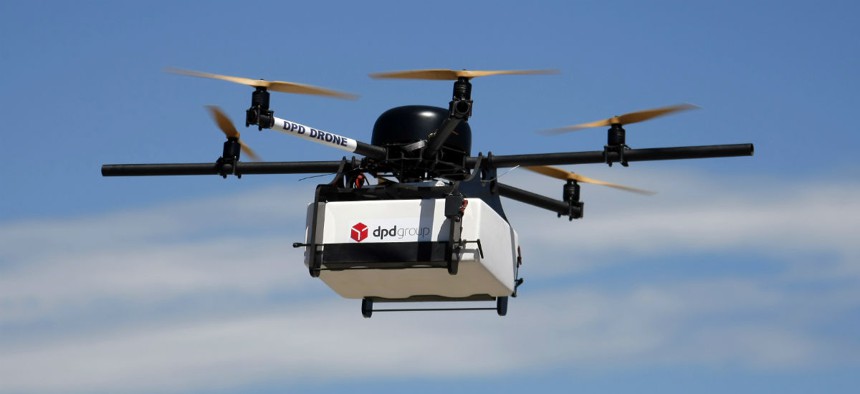Sorry, Drones and Self-Driving Cars Won’t Be Delivering Your Amazon Packages Anytime Soon

A DPD Geopost prototype drone files carrying a parcel flies during a test flight in Pourrieres, southern France, June 23, 2015. Claude Paris/AP
With urban congestion bad and getting worse, how will we get all our packages?
E-commerce means more deliveries than ever will pour into the world’s cities. By 2020, e-commerce sales are expected to rise 85%, auguring a flood of packages. With urban congestion bad and getting worse, how will we get all those packages?
High-tech solutions to last-mile delivery have been on the horizon for decades, say logistics experts. But instead of jet packs, mostly we have gotten Amazon lockers and more night-time deliveries. Not bad, but it’s certainly not aerial drones (which remain impractical and illegal in most cities depite UPS’ experimental drone truck).
Urban logistics have confounded experts and optimists for decades. Despite the technical revolution that is transforming logistics at distribution centers and shipping routes, it has barely touched last-mile delivery in the world’s metropolises.
Cities present a perfect barrier of fixed infrastructure, sunk costs, and misaligned incentives where private sector actors refuse to cooperate, and public officials shy away from investing money in novel solutions. That comes at a cost: Cities lose as much as 4% of their GDP through wasted time and fuel as well as inefficiencies.
McKinsey looked for answers by assessing more than 20 logistical solutions now within reach as part of its September report on urban commercial transport. The firm’s analysis ranked the overall impact of each option based on costs, feasibility, and expected customer and environmental benefits. McKinsey found six solutions that it believes could reduce tail pipe emissions by at least 30% (or 100% with electrification) and parcel costs by 25% to 50%.
The top six were urban warehouses to consolidate packages from disparate sources, electric vehicles, load sharing to match cargo with spare capacity in commercial vehicles, drop boxes for parcels in businesses and residential buildings, and small self-driving vehicles to deliver parcels to their final destination. Despite “significant momentum,” the report states, “we believe that change will happen faster than many people expect.”
But experts are skeptical.
“Some of those things been around for long time,” says Rutgers professor and supply chain expert Rudi Leuschne. “The question is, can you actually line up everyone to make it happen?” The biggest challenge is replacing and modifying old systems. Physical infrastructure as well as economic barriers such as competing delivery firms present massive hurdles for cities wishing to overhaul delivery. “I don’t see any huge changes” in the near future, predicts Leuschne.
That’s not to say nothing will change. Amazon has a Flex program to hire drivers on-demand to deliver packages during crunch periods, shaving off expensive peak delivery costs. Autonomous vehicles are almost ready to transform point-to-point shipping on highways (albeit outside of cities).
But whisking packages to their urban destinations with self-driving trucks and electric drones is probably a long way off, says Chris Caplice, executive director of the MIT Center for Transportation and Logistics. “A lot this stuff is more evolutionary than revolutionary,” he says.
NEXT STORY: NASA Says Goodbye to Its Saturn Probe





